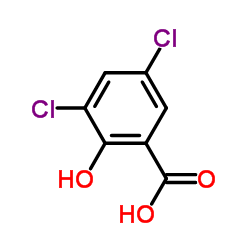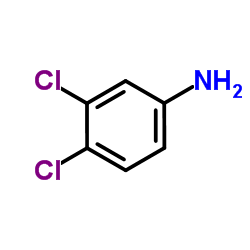1154-59-2
| 中文名 | 3,3,4,5-四氯水杨酰苯胺 |
|---|---|
| 英文名 | 3,3',4',5-tetrachlorosalicylanilide |
| 中文别名 | 3,3',4',5-四氯水杨酰苯胺 |
| 英文别名 |
Caswell No. 833
SALICYLANILIDE,3,3',4',5-TETRACHLORO 3,3',4',5-Tetrachlorosalicylanilide Irgasan BS-200 3,5-Dichlorosalicyl 3,4-dichloroanilide Benzamide,3,5-dichloro-N-(3,4-dichlorophenyl)-2-hydroxy EINECS 214-576-8 TCSA 3,5-dichloro-N-(3,4-dichloro-phenyl)-2-hydroxy-benzamide Tetrachlorosalicylanilide 3,5,3',4'-tetrachlorosalicylanilide 3,5-dichloro-N-(3,4-dichlorophenyl)-2-hydroxybenzamide 3,3′,4′,5-Tetrachlorosalicylanilide |
| 密度 | 1.636 g/cm3 |
|---|---|
| 沸点 | 408.1ºC at 760 mmHg |
| 熔点 | 162ºC |
| 分子式 | C13H7Cl4NO2 |
| 分子量 | 351.01200 |
| 闪点 | 200.6ºC |
| 精确质量 | 348.92300 |
| PSA | 49.33000 |
| LogP | 5.33110 |
| 蒸汽压 | 3.03E-07mmHg at 25°C |
| 折射率 | 1.693 |
| 储存条件 | 密封储存,储存于阴凉、干燥的库房。 |
| 稳定性 | 避免与不相容材料接触。 与强氧化剂反应。 |
| 分子结构 | 1、摩尔折射率:82.29 2、摩尔体积(cm3/mol):214.5 3、等张比容(90.2K):605.3 4、表面张力(dyne/cm):63.4 5、介电常数:无可用的 6、极化率(10-24cm3):32.62 7、单一同位素质量:348.923089 Da 8、标称质量:349 Da 9、平均质量:351.0122 Da |
| 计算化学 | 1.疏水参数计算参考值(XlogP):无 2.氢键供体数量:2 3.氢键受体数量:2 4.可旋转化学键数量:2 5.互变异构体数量:7 6.拓扑分子极性表面积49.3 7.重原子数量:20 8.表面电荷:0 9.复杂度:357 10.同位素原子数量:0 11.确定原子立构中心数量:0 12.不确定原子立构中心数量:0 13.确定化学键立构中心数量:0 14.不确定化学键立构中心数量:0 15.共价键单元数量:1 |
| 更多 | 1. 性状:灰白色或米色结晶性粉末 2. 密度(g/mL,25℃):未确定 3. 相对蒸汽密度(g/mL,空气=1):未确定 4. 熔点(ºC):162 5. 沸点(ºC,常压):未确定 6. 沸点(ºC,12mmHg):未确定 7. 折射率(n20/D):未确定 8. 闪点(ºC):未确定 9. 比旋光度(º):未确定 10. 自燃点或引燃温度(ºC):未确定 11. 蒸气压(kPa,55ºC):未确定 12. 饱和蒸气压(kPa,25ºC):未确定 13. 燃烧热(KJ/mol):未确定 14. 临界温度(ºC):未确定 15. 临界压力(KPa):未确定 16. 油水(辛醇/水)分配系数的对数值:未确定 17. 爆炸上限(%,V/V):未确定 18. 爆炸下限(%,V/V):未确定 19. 溶解性:微溶于水 |
Synonym:Benzamide,3,5-Dichloro-N-(3,4-Dichlorophenyl)-2-Hydroxy Section 2 - COMPOSITION, INFORMATION ON INGREDIENTS
Risk Phrases: 22 Section 3 - HAZARDS IDENTIFICATION EMERGENCY OVERVIEW
Harmful if swallowed.The toxicological properties of this material have not been fully investigated. Potential Health Effects Eye: May cause eye irritation. Skin: May cause skin irritation. Ingestion: Harmful if swallowed. May cause irritation of the digestive tract. Inhalation: May cause respiratory tract irritation. The toxicological properties of this substance have not been fully investigated. Chronic: No information found. Section 4 - FIRST AID MEASURES Eyes: Flush eyes with plenty of water for at least 15 minutes, occasionally lifting the upper and lower eyelids. Get medical aid. Skin: Get medical aid. Flush skin with plenty of water for at least 15 minutes while removing contaminated clothing and shoes. Wash clothing before reuse. Ingestion: Get medical aid. Do NOT induce vomiting. If conscious and alert, rinse mouth and drink 2-4 cupfuls of milk or water. Inhalation: Remove from exposure and move to fresh air immediately. If not breathing, give artificial respiration. If breathing is difficult, give oxygen. Get medical aid. Notes to Physician: Section 5 - FIRE FIGHTING MEASURES General Information: As in any fire, wear a self-contained breathing apparatus in pressure-demand, MSHA/NIOSH (approved or equivalent), and full protective gear. During a fire, irritating and highly toxic gases may be generated by thermal decomposition or combustion. Extinguishing Media: Use agent most appropriate to extinguish fire. Use water spray, dry chemical, carbon dioxide, or appropriate foam. Section 6 - ACCIDENTAL RELEASE MEASURES General Information: Use proper personal protective equipment as indicated in Section 8. Spills/Leaks: Vacuum or sweep up material and place into a suitable disposal container. Clean up spills immediately, observing precautions in the Protective Equipment section. Avoid generating dusty conditions. Provide ventilation. Section 7 - HANDLING and STORAGE Handling: Wash thoroughly after handling. Remove contaminated clothing and wash before reuse. Use with adequate ventilation. Minimize dust generation and accumulation. Avoid contact with eyes, skin, and clothing. Keep container tightly closed. Avoid ingestion and inhalation. Storage: Store in a tightly closed container. Store in a cool, dry, well-ventilated area away from incompatible substances. Section 8 - EXPOSURE CONTROLS, PERSONAL PROTECTION Engineering Controls: Facilities storing or utilizing this material should be equipped with an eyewash facility and a safety shower. Use adequate ventilation to keep airborne concentrations low. Exposure Limits CAS# 1154-59-2: Personal Protective Equipment Eyes: Wear appropriate protective eyeglasses or chemical safety goggles as described by OSHA's eye and face protection regulations in 29 CFR 1910.133 or European Standard EN166. Skin: Wear appropriate protective gloves to prevent skin exposure. Clothing: Wear appropriate protective clothing to prevent skin exposure. Respirators: A respiratory protection program that meets OSHA's 29 CFR 1910.134 and ANSI Z88.2 requirements or European Standard EN 149 must be followed whenever workplace conditions warrant respirator use. Section 9 - PHYSICAL AND CHEMICAL PROPERTIES Physical State: Solid Color: white to off-white Odor: Not available. pH: Not available. Vapor Pressure: Not available. Viscosity: Not available. Boiling Point: Not available. Freezing/Melting Point: 162 deg C Autoignition Temperature: Not applicable. Flash Point: Not applicable. Explosion Limits, lower: Not available. Explosion Limits, upper: Not available. Decomposition Temperature: Solubility in water: Specific Gravity/Density: Molecular Formula: C13H7Cl4NO2 Molecular Weight: 351.01 Section 10 - STABILITY AND REACTIVITY Chemical Stability: Stable under normal temperatures and pressures. Conditions to Avoid: Incompatible materials, dust generation, excess heat, strong oxidants. Incompatibilities with Other Materials: Oxidizing agents. Hazardous Decomposition Products: Carbon monoxide, oxides of nitrogen, irritating and toxic fumes and gases, carbon dioxide, oxides of chlorine. Hazardous Polymerization: Has not been reported Section 11 - TOXICOLOGICAL INFORMATION RTECS#: CAS# 1154-59-2: VN8900000 LD50/LC50: CAS# 1154-59-2: Oral, rat: LD50 = 243 mg/kg. Carcinogenicity: Benzamide,3,5-dichloro-n-(3,4-dichlorophenyl)-2-hydroxy- - Not listed by ACGIH, IARC, or NTP. Other: See actual entry in RTECS for complete information. Section 12 - ECOLOGICAL INFORMATION Section 13 - DISPOSAL CONSIDERATIONS Dispose of in a manner consistent with federal, state, and local regulations. Section 14 - TRANSPORT INFORMATION IATA Not regulated as a hazardous material. IMO Not regulated as a hazardous material. RID/ADR Not regulated as a hazardous material. Section 15 - REGULATORY INFORMATION European/International Regulations European Labeling in Accordance with EC Directives Hazard Symbols: XN Risk Phrases: R 22 Harmful if swallowed. Safety Phrases: S 28A After contact with skin, wash immediately with plenty of water. S 37 Wear suitable gloves. S 45 In case of accident or if you feel unwell, seek medical advice immediately (show the label where possible). WGK (Water Danger/Protection) CAS# 1154-59-2: No information available. Canada CAS# 1154-59-2 is listed on Canada's DSL List. CAS# 1154-59-2 is not listed on Canada's Ingredient Disclosure List. US FEDERAL TSCA CAS# 1154-59-2 is listed on the TSCA inventory. SECTION 16 - ADDITIONAL INFORMATION N/A |
|
毒理学数据: 1、皮肤/眼睛刺激性 开放的刺激试验:兔子,皮肤接触:150μg,反应的严重程度:轻度。 开放的刺激试验:豚鼠,皮肤接触:150μg,反应的严重程度:轻度。 2、急性毒性:大鼠经口LD50:243mg/kg; 生态学数据: 对环境有危害,对水体有污染,禁止进入水体。 CHEMICAL IDENTIFICATION
HEALTH HAZARD DATAACUTE TOXICITY DATA
|
| 危害码 (欧洲) | Xn: Harmful; |
|---|---|
| 风险声明 (欧洲) | R22 |
| 海关编码 | 2924299090 |
|
~91% 
1154-59-2 |
| 文献:Archiv der Pharmazie, , vol. 331, # 1 p. 3 - 6 |
|
~% 
1154-59-2 |
| 文献:Bioorganic and Medicinal Chemistry Letters, , vol. 18, # 11 p. 3173 - 3177 |
| 海关编码 | 2924299090 |
|---|---|
| 中文概述 | 2924299090. 其他环酰胺(包括环氨基甲酸酯)(包括其衍生物以及他们的盐). 增值税率:17.0%. 退税率:13.0%. 监管条件:无. 最惠国关税:6.5%. 普通关税:30.0% |
| 申报要素 | 品名, 成分含量, 用途, 包装 |
| Summary | 2924299090. other cyclic amides (including cyclic carbamates) and their derivatives; salts thereof. VAT:17.0%. Tax rebate rate:13.0%. . MFN tariff:6.5%. General tariff:30.0% |




